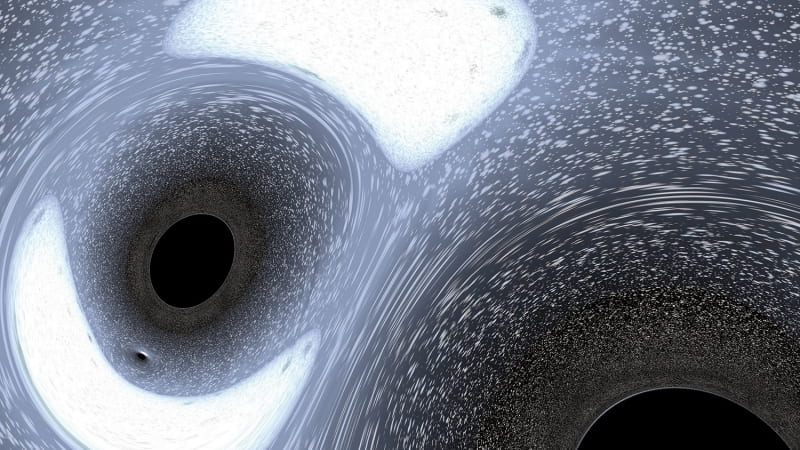ASTRONOMY FUGATO: TWO APPROACHES, ONE VAST FIELD OF DISCOVERY
By: Shi Ye

Black Hole Encounter, Aaron’s Geller’s 1st prize image from the 2017 Northwestern Scientific Images contest, depicts a computer simulation of black holes bending startlight in a dense globular cluster.
Last week, my mother called from the other side of the Pacific Ocean. After chatting about the weather in Chicago and what I had for dinner recently, she turned to my work. “Can you tell me again what you do for research? Do you observe the stars every night?” “No, Mom,” I said, “I’m a theorist.”
Theorists like me do not observe the sky directly. We are more interested in the “why” and “how” of astronomy. For example, why are there rock rings around Saturn? Why is there a supermassive black hole in the center of the Milky Way galaxy? How do binary black holes (a system of two black holes orbiting each other closely) form?
As an astronomical theorist, my standard work day goes something like this: Connect to Northwestern supercomputers and check the status of my star simulations (Finished running! Great!). Next, compare the data produced by the simulations to real observations to check if they match well. Lunch time. Group meeting. (Happy, did well on my research; not so happy, did something wrong.) Run some new models based on the discussions from the group meeting. Go home at 6:00 pm and read papers in the evening. (No telescope and no observations at night!)
I joined my research team last fall. Together we study the dynamics of stars— calculating their motions under the influence of gravitational forces—with computer simulations that waltz in tune with the stars’ speeds and circular patterns.
Observers are the other camp in the astronomy research community. As the name suggests, observers watch the sky using observatories, such as the Hubble Space Telescope and the Laser Interferometer Gravitational-Wave Observatory (LIGO). Observers collect data about astronomical objects and study their properties, such as the brightness of the Sun, the explosion duration of a supernova, and the habitability of exoplanets. Some observers also build telescopes. Observers are the ones who truly “watch the stars every night.”
Last February, the LIGO team announced the first gravitational waves detection created from binary black hole mergers. (This discovery was so momentous the LIGO founders won the 2017 Nobel Prize in Physics.) About the same time, my theoretical colleagues proposed the mechanism behind binary black holes like these: we calculated their origins in globular star clusters. Globular clusters are collections of stars (including black holes and stars like our Sun). They orbit the Milky Way Galaxy and other galaxies.
In globular clusters, stellar-mass black holes are born from the collapse of old, massive stars. In the collapse, the mass of a star is pulled into a small region around the star center; a region so small that spacetime is twisted — and nothing, not even light, can escape. Once formed, these incredibly dense black holes tend to slide to the center of the cluster.
When we run computer simulations of these processes, some clusters are crowded, containing up to a few hundred black holes. In these crowded clusters, black holes can bump into each other or other massive stars easily – and these black hole interactions can come in many forms. Under special circumstances, a group of three black holes may convene and then two of them stay together, forming binary black holes. In other instances, black holes can “bully” less dense stars. Because black holes are so massive, they can intrude into existing star binaries, kick out lighter stars, and take their positions. Some of these newly formed black hole binaries are then ejected from the clusters.
Sometimes black holes can even collide. The first gravitational waves detected by LIGO were produced by the collision of two black holes each about 30 times more massive than our Sun. Before this discovery, astronomers predicted far less massive black holes would be observed in this type of collision. The massiveness of the black holes involved in this groundbreaking observation indicates they can originate in the unique environment of a globular cluster – just like those in our simulations.
Theoretical and observational studies often go hand in hand like this. For example, Albert Einstein was a theorist and he predicted the existence of gravitational waves. But it took the construction of LIGO and both observers and theorists in the LIGO team to detect them. In turn, observations of gravitational waves provide real data of existing black holes, which help theorists develop and refine the binary black hole formation models.
Understanding the evolution and the origin of globular clusters are essential to many aspects of astronomy, such as how stars form and the evolution of the Milky Way galaxy itself. Observers and theorists have an equally important role in the study of the binary black hole mergers and the globular clusters. Together, we play a splendid fugato in the dawning of this new astronomy era.
As I said on the phone to my mom, “Mom, I don’t watch the stars every night. But I can still learn a lot about our universe by ‘watching’ them on the computer screens!”
This article began as a class assignment for Skills & Careers in Science Writing, a graduate-level science writing course focusing on building compelling narratives and employing storytelling techniques to illuminate contemporary research. The course is a partnership between Science in Society, The Graduate School, and the Medill School of Journalism, Media, and Integrated Marketing Communications at Northwestern University.
